北京著名地方英文版
- 格式:docx
- 大小:13.11 KB
- 文档页数:2
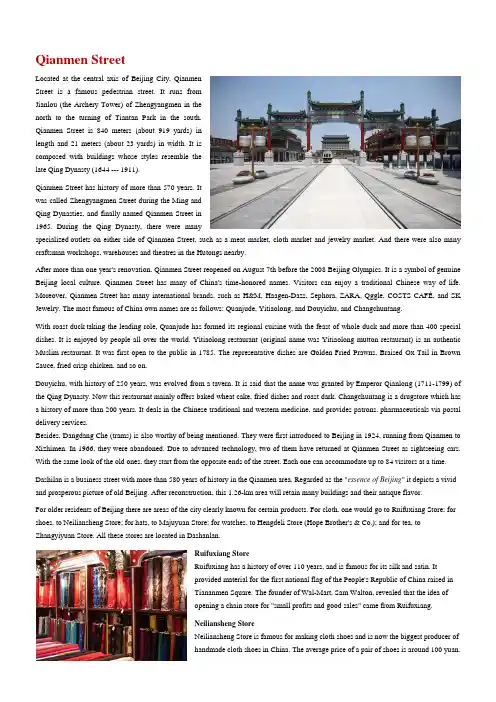
Qianmen StreetLocated at the central axis of Beijing City, QianmenStreet is a famous pedestrian street. It runs fromJianlou (the Archery Tower) of Zhengyangmen in thenorth to the turning of Tiantan Park in the south.Qianmen Street is 840 meters (about 919 yards) inlength and 21 meters (about 23 yards) in width. It iscomposed with buildings whose styles resemble thelate Qing Dynasty (1644 --- 1911).Qianmen Street has history of more than 570 years. Itwas called Zhengyangmen Street during the Ming andQing Dynasties, and finally named Qianmen Street in1965. During the Qing Dynasty, there were manyspecialized outlets on either side of Qianmen Street, such as a meat market, cloth market and jewelry market. And there were also many craftsman workshops, warehouses and theatres in the Hutongs nearby.After more than one year's renovation, Qianmen Street reopened on August 7th before the 2008 Beijing Olympics. It is a symbol of genuine Beijing local culture. Qianmen Street has many of China's time-honored names. Visitors can enjoy a traditional Chinese way of life. Moreover, Qianmen Street has many international brands, such as H&M, Haagen-Dazs, Sephora, ZARA, Qggle, COSTS CAFÉ, and SK Jewelry. The most famous of China own names are as follows: Quanjude, Yitiaolong, and Douyichu, and Changchuntang.With roast duck taking the leading role, Quanjude has formed its regional cuisine with the feast of whole duck and more than 400 special dishes. It is enjoyed by people all over the world. Yitiaolong restaurant (original name was Yitiaolong mutton restaurant) is an authentic Muslim restaurant. It was first open to the public in 1785. The representative dishes are Golden Fried Prawns, Braised Ox Tail in Brown Sauce, fried crisp chicken, and so on.Douyichu, with history of 250 years, was evolved from a tavern. It is said that the name was granted by Emperor Qianlong (1711-1799) of the Qing Dynasty. Now this restaurant mainly offers baked wheat cake, fried dishes and roast dark. Changchuntang is a drugstore which has a history of more than 200 years. It deals in the Chinese traditional and western medicine, and provides patrons, pharmaceuticals via postal delivery services.Besides, Dangdang Che (trams) is also worthy of being mentioned. They were first introduced to Beijing in 1924, running from Qianmen to Xizhimen. In 1966, they were abandoned. Due to advanced technology, two of them have returned at Qianmen Street as sightseeing cars. With the same look of the old ones, they start from the opposite ends of the street. Each one can accommodate up to 84 visitors at a time. Dashilan is a business street with more than 580 years of history in the Qianmen area. Regarded as the "essence of Beijing" it depicts a vivid and prosperous picture of old Beijing. After reconstruction, this 1.26-km area will retain many buildings and their antique flavor.For older residents of Beijing there are areas of the city clearly known for certain products. For cloth, one would go to Ruifuxiang Store; for shoes, to Neiliansheng Store; for hats, to Majuyuan Store; for watches, to Hengdeli Store (Hope Brother's & Co.); and for tea, to Zhangyiyuan Store. All these stores are located in Dashanlan.Ruifuxiang StoreRuifuxiang has a history of over 110 years, and is famous for its silk and satin. Itprovided material for the first national flag of the People's Republic of China raised inTiananmen Square. The founder of Wal-Mart, Sam Walton, revealed that the idea ofopening a chain store for "small profits and good sales" came from Ruifuxiang.Neiliansheng StoreNeiliansheng Store is famous for making cloth shoes and is now the biggest producer ofhandmade cloth shoes in China. The average price of a pair of shoes is around 100 yuan.The cloth shoes have become increasingly popular as people around the world have become more interested in ecological issues.Xianyukou Street, Time-Honored Food Brand Area in BeijingXianyukou Street, near the famous Qianmen Street, has justreopened to the public this month. After a three-year renovation, the570-year-old commercial street has been restored into a Chinatime-honored food brand area. All China time-honored brands likeBianyifang Roast Duck Restaurant and Tianxingju Fried Liver hasreturned this street to excite the Beijing old memory and taste.The first part of its name, "Xian Yu”, translates to "Fresh Fish" inEnglish, indicating the culinary history of the street. Thenewly-paved street pays homage to its history in a number of details,from fish-adorned manhole covers to brick sculptures, urbanfurniture, and even streetlights.On a sunny afternoon the day after opening, the street was floodedwith visitors getting a taste of old Beijing. Many shops sell old Beijing snacks and specialties and boast a golden plaque telling the public of their origins in the 19th and early 20th centuries. Several shops had a queue extending out the front door and onto the street, with shoppers waiting for old Beijing confections, stewed liver, and even roasted meat.Besides the Beijing local restaurants and traditional snacks, many regional or international dishes and goods with ethnic and cultural flavor can be found in this street, too.Xianyukou Street perfectly embraces Beijing's hutong past. During Ming and Qing Dynasties, most residences were 1-story courtyard houses and the city's shops occupied 1 or 2-story buildings along narrow streets. Walking along the alley, paved with bricks instead of asphalt, visitors will gain a glimpse of the city's profound history.While old brands and traditional snacks and crafts are disappearing from other parts of the city, they have been revived in Xianyukou Street. The popular opening of the new Xianyukou Street proves that old Beijing has never lost but still remains unique and attractive.Wangfujing Street - biggest commercial center of BeijingWangfujing is now considered as the central heart of Beijing City. It is thefirst modern-style commercial street in Beijing, about 800 meters long andon two sides of it standing many stores and malls. A walk from end to endwould take you about 30 mins, and that's without looking at any shops andmalls.Layout of Wangfujing StreetIt starts from Wangfujing Nankou, where the Oriental Plaza and the BeijingHotel are located. It then heads north, passing the Wangfujing XinhuaBookstore, the Beijing Department Store as well as the Beijing ForeignLanguage Bookstore before ending at the Sun Dong An Plaza.Much of the road is off-limits to cars and other motor vehicles, and it is not rare to see the entire street full of people. It is embellished with squares, lawns, flower beds, fountains, ornamental columns, sculptures and benches. This pleasant environment has made shopping an exercise in fashionable leisure.Wangfujing Department StoreIt is comparable to Bloomingdales. Unlike shanghai, beijing has less luxury department stores and this is the most popular, situated in the hip wang fu jing street, it carries many foreign brands such as Calvin Klein, Nina Ricce, Gucci, Prada, Lanvin etc. The first floor is home to cosmetic brands such as Christian Dior, Elizabeth Arden and Guerlain and boutiques like Mondi, Yves Saint Laurent, Nina Ricci, D'urban and Charles Jourdan. The second floor houses the ladies department, lingerie, accessories and leather bags plus a coffee shop. The third floor has the men's department, and on the fourth floor are children's clothes, toys (plenty of foreign brands) and household items.Snack Street in WangfujingThe Wangfujing Night Market has a selection of exotic Street food on the Snack Street. Deep fried insects, scorpions, and sea creatures can be found, along with other animals and animal parts not ordinarily consumed as food in the west. But while these exotic snacks can be found, other more common foods, such as Chuanr (meat kebabs, commonly made of lamb) and desserts, such as Tang hu lu, or candied fruits make up the majority of the food sold on the street.Wangfujing at NightThe stores of Wangfujing Street close at 9PM, but a small night market stays open after that which caters to tourists. The night market consists of vendor stalls that stretch along a few blocks of side streets and alleys that branch off from Wangfujing Street near the southern end of its pedestrian mall section.Most of the stalls sell either souvenirs or food. The souvenirs are the same things that you see in shops all over the city, and you will have to bargain to get down to the right price. We shopped for postcards and Christmas ornaments there. The food on offer in the food stalls ranges from ordinary (ice cream) to unusual (scorpion-on-a-stick and seahorse-on-a-stick are a couple of the stranger ones that we saw).For souvenirs, try to buy them for about 1/3 of the asking price. You will have to bargain for a few rounds and walk away once or twice to get to the right price.Old-Beijing-Street in WangfujingThe Old-Beijing-Street which is located on Wangfujing Dajie (-1/F, Xin Dong AnPlaza) is an underground street built in Ming and Qing styles. The outstandingcharacteristic of it is the centralized well-known longstanding stores selling shoes,caps, silk cloth, scissors, Chinese brushes and ink-stick, jade, teas, desserts, pickledvegetables and roast duck. Beijing Craftwork and Art Mansion specially operatesvarious industrial arts and artworks, and is famed all over Beijing, and is an old shopin Wangfujing Street.Beijing Local Snacks:Beijing has a time-honored history of producing various kinds of snacks. With strong flavors, Beijing's snacks attract almost all visitors. Typical Beijing snacks include:Sticky rice with sweet fillings (Ai Wo Wo,): As white as snow, this delicacy is made of sticky rice.Pancakes with sweetened bean paste filling (Douxian Shaobing,): This is a very popular Beijing snack. Crisp outside, they are soft and sweet inside.Sticky rice cake with a layer of sweetened bean paste (Qiegao,)Pea Flour Cake (Wandouhuang )Pastry Made of Soy Bean Flour (Ludagun)Douxian Shaobing: typical snack of Old BeijingLudagun will delight you with its sugary filling, yummy...Quanjude (全聚德)The well-known All-Duck Banquet is headed by Quanjude roast duck and supported by over 400 dishes with Quanjude characteristic flavor. Government leaders, officials and VIPs from nearly 200 countries and regions have visited Quanjude roast duck restaurants and had dinner here. Foreign credit cards are accepted here. Watch the Videos of Quanjude Roast Duck Restaurant.。
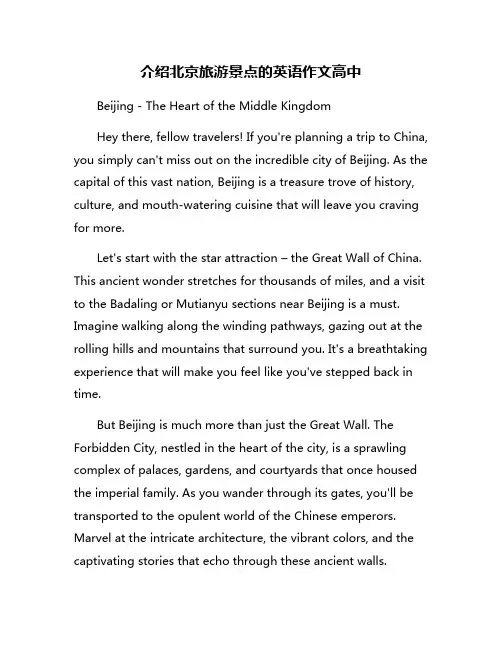
介绍北京旅游景点的英语作文高中Beijing - The Heart of the Middle KingdomHey there, fellow travelers! If you're planning a trip to China, you simply can't miss out on the incredible city of Beijing. As the capital of this vast nation, Beijing is a treasure trove of history, culture, and mouth-watering cuisine that will leave you craving for more.Let's start with the star attraction – the Great Wall of China. This ancient wonder stretches for thousands of miles, and a visit to the Badaling or Mutianyu sections near Beijing is a must. Imagine walking along the winding pathways, gazing out at the rolling hills and mountains that surround you. It's a breathtaking experience that will make you feel like you've stepped back in time.But Beijing is much more than just the Great Wall. The Forbidden City, nestled in the heart of the city, is a sprawling complex of palaces, gardens, and courtyards that once housed the imperial family. As you wander through its gates, you'll be transported to the opulent world of the Chinese emperors. Marvel at the intricate architecture, the vibrant colors, and the captivating stories that echo through these ancient walls.Speaking of stories, you can't leave Beijing without visiting the Summer Palace. This vast ensemble of lakes, gardens, and pavilions was once the imperial retreat for the Qing Dynasty rulers. Stroll along the Long Corridor, a covered walkway adorned with thousands of intricate paintings, and lose yourself in the tranquil beauty of the Kunming Lake and the Marble Boat.If you're a fan of temples and religious sites, Beijing has plenty to offer. The Temple of Heaven, with its iconic blue-tiled roofs and intricate carvings, is a masterpiece of ancient Chinese architecture and philosophy. Attend one of the early morning ceremonies, where locals gather to practice tai chi or play traditional instruments, and immerse yourself in the serene atmosphere.But Beijing isn't just about the past – it's also a thriving modern metropolis. Head to the iconic Tiananmen Square, the heart of the city, and soak in the energy and grandeur of this vast public space. From there, you can explore the trendy Sanlitun neighborhood, brimming with cafes, shops, and lively nightlife.Of course, no visit to Beijing would be complete without indulging in the city's legendary cuisine. From the mouthwatering Peking duck to the delectable dumplings and noodle dishes, your taste buds will be in for a delightful treat.Don't miss out on the vibrant food streets and night markets, where you can sample an array of local delicacies and street snacks.As you wander through the bustling streets of Beijing, you'll be struck by the seamless blend of ancient and modern, tradition and innovation. This city is a living, breathing testament to China's rich heritage and its vibrant present.So, what are you waiting for? Pack your bags, grab your camera, and get ready to embark on an unforgettable journey through the heart of the Middle Kingdom. Beijing awaits, and its wonders will leave you enchanted, inspired, and craving for more of this captivating city.。
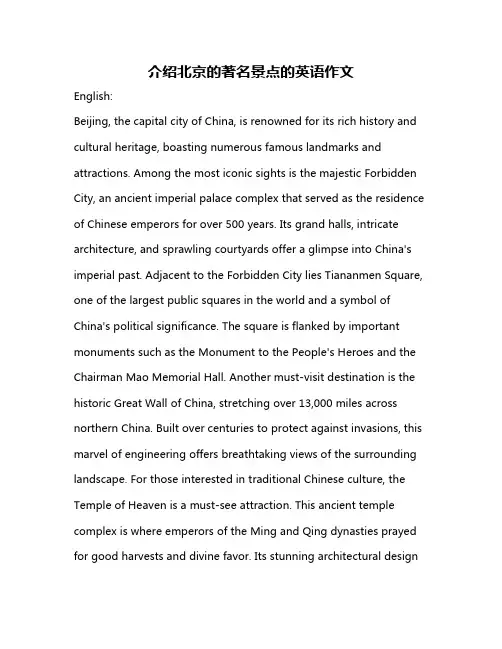
介绍北京的著名景点的英语作文English:Beijing, the capital city of China, is renowned for its rich history and cultural heritage, boasting numerous famous landmarks and attractions. Among the most iconic sights is the majestic Forbidden City, an ancient imperial palace complex that served as the residence of Chinese emperors for over 500 years. Its grand halls, intricate architecture, and sprawling courtyards offer a glimpse into China's imperial past. Adjacent to the Forbidden City lies Tiananmen Square, one of the largest public squares in the world and a symbol of China's political significance. The square is flanked by important monuments such as the Monument to the People's Heroes and the Chairman Mao Memorial Hall. Another must-visit destination is the historic Great Wall of China, stretching over 13,000 miles across northern China. Built over centuries to protect against invasions, this marvel of engineering offers breathtaking views of the surrounding landscape. For those interested in traditional Chinese culture, the Temple of Heaven is a must-see attraction. This ancient temple complex is where emperors of the Ming and Qing dynasties prayed for good harvests and divine favor. Its stunning architectural designand serene atmosphere make it a favorite among visitors. Additionally, the Summer Palace, a vast imperial garden with beautiful pavilions, bridges, and lakes, offers a peaceful retreat from the bustling city. With its blend of ancient history and modern development, Beijing stands as a fascinating destination for travelers seeking to explore China's rich cultural heritage.Translated content:北京,中国的首都,以其丰富的历史和文化遗产而闻名,拥有许多著名的地标和景点。
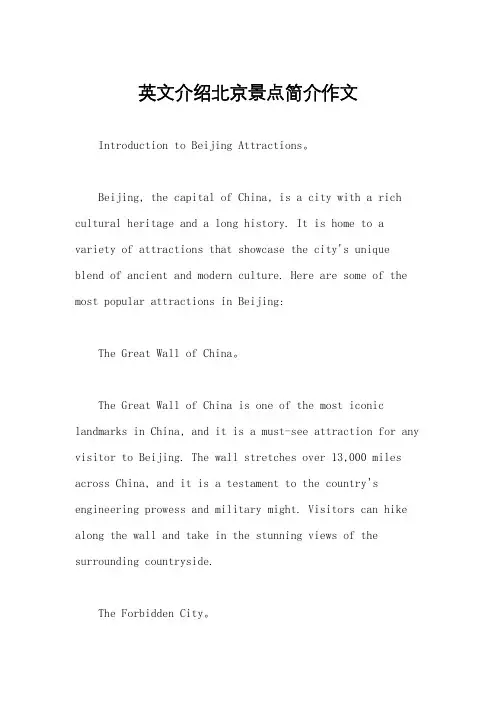
英文介绍北京景点简介作文Introduction to Beijing Attractions。
Beijing, the capital of China, is a city with a rich cultural heritage and a long history. It is home to a variety of attractions that showcase the city's unique blend of ancient and modern culture. Here are some of the most popular attractions in Beijing:The Great Wall of China。
The Great Wall of China is one of the most iconic landmarks in China, and it is a must-see attraction for any visitor to Beijing. The wall stretches over 13,000 miles across China, and it is a testament to the country's engineering prowess and military might. Visitors can hike along the wall and take in the stunning views of the surrounding countryside.The Forbidden City。
The Forbidden City is a massive palace complex that was once the home of China's emperors. It is a UNESCO World Heritage Site and one of the most popular tourist attractions in Beijing. Visitors can explore the palace's many halls, pavilions, and gardens, and learn about the history of the Ming and Qing dynasties.Tiananmen Square。
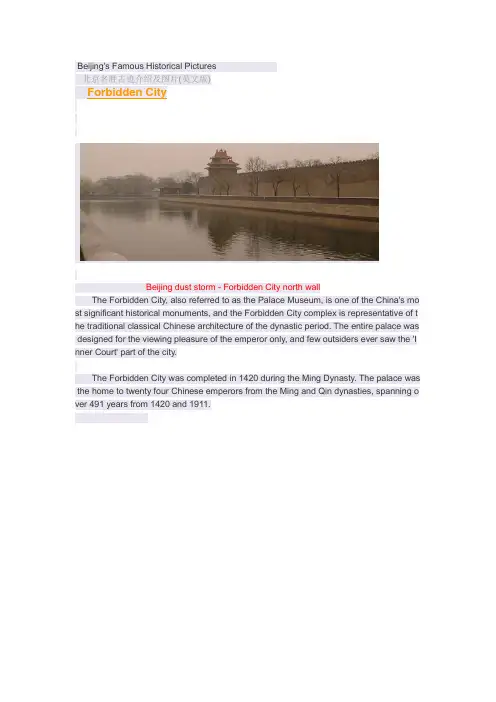
Beijing's Famous Historical Pictures北京名胜古迹介绍及图片(英文版)Forbidden CityBeijing dust storm - Forbidden City north wallThe Forbidden City, also referred to as the Palace Museum, is one of the China's mo st significant historical monuments, and the Forbidden City complex is representative of t he traditional classical Chinese architecture of the dynastic period. The entire palace was designed for the viewing pleasure of the emperor only, and few outsiders ever saw the 'I nner Court' part of the city.The Forbidden City was completed in 1420 during the Ming Dynasty. The palace was the home to twenty four Chinese emperors from the Ming and Qin dynasties, spanning o ver 491 years from 1420 and 1911.Tai'he Gate Square - Looking at the north Meridian GateThe Meridian Gate (above) was constructed in 1420, and is the main gate of the Forbidd en City. It was used primarily by the emperor, who always entered from the south. The M eridian Gate is over 37 meters high, and is the second main gate after the outer-most 'Tia n'anmen Gate' or "Gate of Heavenly Peace."Tai'he Gate SquareWithin the Tai'he Gate Square lies the Golden Water River, which snakes through the squ are like a winding jade belt. Five marble bridges span the Golden Water River. The use of wide open space was designed to limit an invader's ability to hide. The stone flooring in t he square was several layers thick to prevent someone from tunneling into the compound.Tai'he Gate Square - Golden Water RiverThe Forbidden City occupies a total space of more than 720,000 square meters, surroun ded on three sides by imperial gardens. The entire complex is surrounded by a 50 meter wide moat and a 10 meter high wall with watch towers at each of its corners. The palace walls have a total length of 3,400 metres.The Forbidden City complex consists of two main parts: the 'Outer Court' and the 'Inner C ourt.' The Forbidden City complex contains 9,999.5 bays or "rooms," which is .5 less roo ms than the 1000 rooms heaven was believed to be.No. 2 Long Alley looking towards the western palacesThe 'Outer Court' centers around the Hall of Preserved Harmony, Hall of Supreme Harmo ny, and the Midway Hall of Harmony, all of which are flanked by the Hall of Literary Glory and the Hall of Military Prowess.At the center of the 'Inner Court' lies the Hall of Celestial Heavenly Purity, Hall of Uni on and Peace, and the Hall of Terrestrial or Earthly Transquility, which are symmetrically f lanked by the Six East Palaces and the Six West Palaces.Jingshan Park & Coal HillTo the north of the Qianqing Gate or "Gate of Obedience and Purity" and directly across f rom the "Gate of Divine Prowess" (aka "Gate of Divine Might") is Jingshan Park, which is also known as Coal Hill or Jing Shan Hill (below). The hill is artificial, created from the soil excavated to build the palace moat and adjoining lakes. To this day Jingshan Park is a p opular morning gathering spot for the locals to preform Tai Chi.Overlooking Qianqing Gate Square and Coal HillChongzheng - The Last Ming EmperorThe last Ming emperor Chongzheng hanged himself atop Jingshan Hill (meaning "Prospe ct Hill" or "Dominating Hill") in 1644, as the rebel Manchu army of Li Zicheng overtook the palace. The Forbidden City is situated to the south of a Jingshan Hill in accordance with t he dictates of Feng Shui. This is why Coal Hill is also known as "Feng Shui Hill."Baohe Hall and Zhonghe Hall marble stepsYangxin Hall - Qing Dynasty ThroneYangxin Hall was where the emperors of the Qing Dynasty met with their ministers.Entrance to the Yangxin HallThe horizontal board above the throne (below left) in Yangxin Hall is inscribed with "Z hong Zheng Ren He," written by Emperor Yong Zheng (1678 - 1735), the fourth emperor of the Manchu Qing Dynasty.Yangxin Hall - Qing Dynasty Throne (left), Ci Xi's Bedroom (right)The wedding bedroom and bridal chambers are surprisingly intimate, possibly due to the need conserve heat during the cold Beijing winters. The bedroom to the right belonged to Empress Ci Xi (Cixi) known as the "Dragon Lady," "Empress Dowager," or "the power be hind the curtain," as she was a surrogate ruler for nearly 50 years.Tai'he Hall - Ming Dynasty ThroneTai'he Hall's gold-painted throne was created during the Ming Dynasty (below left), and w as used to enthrone the emperor when he performed important ceremonies and handed down official edicts. The throne is surrounded by six golden pillars encircled by golden dr agons, and the ceiling contains a phoenix above the throne.Entrance to the Yangxin HallImperial Garden - Yujing & Qiangqiu PavilionThe Imperial garden was constructed using a prized variety of rock known as Taihu Rock that is found at the bottom of Taihu Lake to the west of Suzhou in the Yangtze River Delta . The garden and hill were used to view the Queen to autumn colors that lay outside the p alace walls.Yujing Pavilion Garden - Duixiu Hill made of Taihu RockYujing Pavilion on Duixiu Hill (left), Qiangqiu Pavilion (right)Forbidden City Palace Moat & WallsThe heavily fortified Forbidden City palace is surrounded by a 3,800 meter-long moat that is 52 meters wide, and six meters deep. Behind the moat is a 10 meters high red-painted wall, with watchtowers at each corner.Northwest Palace Wall and City MoatThe Last Emperor - PuyiEmperor Puyi of the Manchu Aisin-Gioro Imperial family was the 12th emperor of the Qin g Dynasty, and the last Emperor of China, from 1908 to 1924.Puyi ascended the throne at the age of two, under the deathbed edict of Dowager Empre ss, Cixi (the "Dragon lady"). Puyi was taken from his home in Peking as an infant, and pla ced in the care of a wet-nurse, Wen-Chao Wang in the Forbidden City.In 1912, China became a Republic following the Xinhai Revolution, and the Monarchy wa s ended. Under the treaty entitled "Articles of Favourable Treatment of the Emperor of the Great Qing after his Abdication," Puyi would retain the symbolic title of "Emperor," and b e provided with an annual stipend of 4 million dollars.After an aborted attempt to revive the monarchy in 1917, Puyi and the rest of his imperial court were held as a virtual prisoners within the walls of the northern section of the Forbid den City and the Summer Palace, under the watchful eyes of the court eunuchs, and Imp erial Guards.Puyi and his concubines were finally evicted from the Forbidden City in 1924. Being of M anchu descent, Puyi was installed as a puppet ruler of Manchukuo in 1932, at the behest of Imperial Japan. Puyi "ruled" Manchukuo until 1945 when the Soviet Red Army drove th e Japanese out of northern China at the end of WWII.Puyi's life story was poignantly told in the 1987 film The Last Emperor, Directed by Berna rdo Bertolucci.Shenwu Gate Palace Watchtower and Southwest City MoatEach year millions of Chinese and foreign visitors stroll through the massive palace grounds to witness the past power, glory, and extravagance of China's notorious emperor s.This page contains maps, diagrams, and satellite imaging of Beijing's Forbidden City Palace Museum, Jingshan Park Beihai Lake, and the surrounding city.Beijing City MapBeijing Palace City Scroll at the National Museum of China, in Beijing Temple of Heaven (Tiantan Park)。
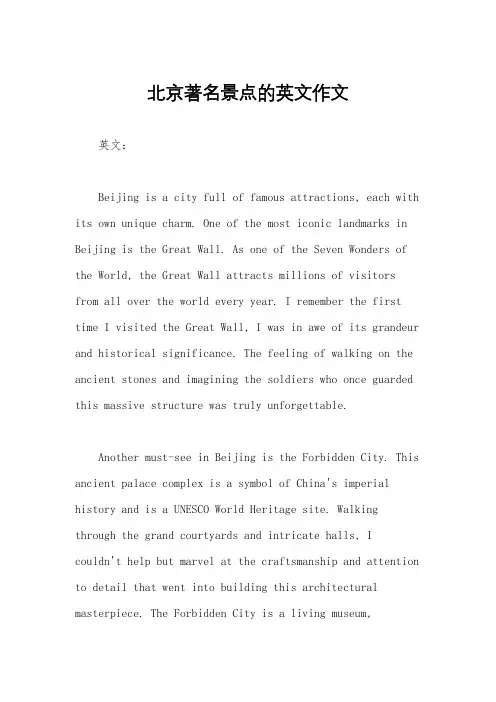
北京著名景点的英文作文英文:Beijing is a city full of famous attractions, each with its own unique charm. One of the most iconic landmarks in Beijing is the Great Wall. As one of the Seven Wonders of the World, the Great Wall attracts millions of visitors from all over the world every year. I remember the first time I visited the Great Wall, I was in awe of its grandeur and historical significance. The feeling of walking on the ancient stones and imagining the soldiers who once guarded this massive structure was truly unforgettable.Another must-see in Beijing is the Forbidden City. This ancient palace complex is a symbol of China's imperial history and is a UNESCO World Heritage site. Walking through the grand courtyards and intricate halls, Icouldn't help but marvel at the craftsmanship and attention to detail that went into building this architectural masterpiece. The Forbidden City is a living museum,preserving the rich history and culture of China.One more famous attraction in Beijing is the Summer Palace, a tranquil retreat from the bustling city. The beautiful gardens, pavilions, and lakes make it a perfect place to escape and relax. I have fond memories of taking a boat ride on the Kunming Lake and admiring the stunning views of the surrounding hills and bridges.中文:北京是一个充满着著名景点的城市,每个景点都有着独特的魅力。
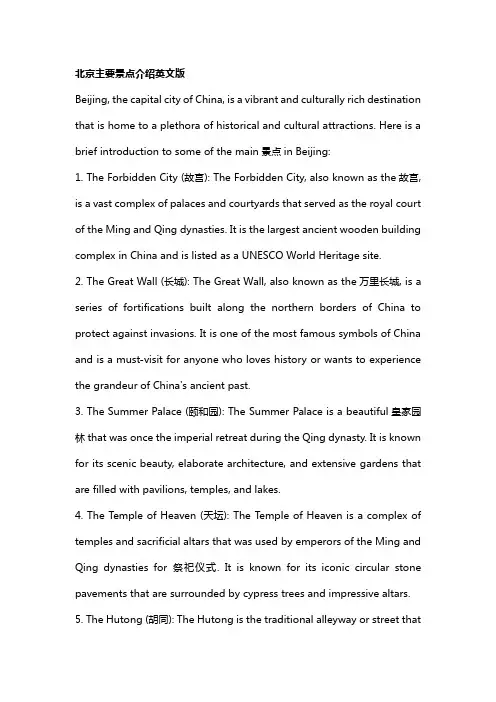
北京主要景点介绍英文版Beijing, the capital city of China, is a vibrant and culturally rich destination that is home to a plethora of historical and cultural attractions. Here is a brief introduction to some of the main景点in Beijing:1. The Forbidden City (故宫): The Forbidden City, also known as the故宫, is a vast complex of palaces and courtyards that served as the royal court of the Ming and Qing dynasties. It is the largest ancient wooden building complex in China and is listed as a UNESCO World Heritage site.2. The Great Wall (长城): The Great Wall, also known as the万里长城, is a series of fortifications built along the northern borders of China to protect against invasions. It is one of the most famous symbols of China and is a must-visit for anyone who loves history or wants to experience the grandeur of China's ancient past.3. The Summer Palace (颐和园): The Summer Palace is a beautiful皇家园林that was once the imperial retreat during the Qing dynasty. It is known for its scenic beauty, elaborate architecture, and extensive gardens that are filled with pavilions, temples, and lakes.4. The Temple of Heaven (天坛): The Temple of Heaven is a complex of temples and sacrificial altars that was used by emperors of the Ming and Qing dynasties for祭祀仪式. It is known for its iconic circular stone pavements that are surrounded by cypress trees and impressive altars.5. The Hutong (胡同): The Hutong is the traditional alleyway or street thatis found in Beijing's old市区and is a unique feature of the city's urban landscape. These narrow lanes are lined with houses, workshops, and workshops that have been standing for generations, offering a glimpse into the daily life of Beijing's residents.6. The Nan Luo Gu Xiang (南锣鼓巷): Nan Luo Gu Xiang is a popular tourist destination that is known for its preserved明清建筑and vibrant atmosphere. This area is filled with trendy cafes, art galleries, and boutique shops that offer a taste of traditional culture and modern urban life in Beijing.These are just a few of the many attractions that await visitors to Beijing. Whether you are interested in history, culture, or just want to experience the pulse of Beijing's modern city life, there is something for everyone to enjoy in this captivating capital city.。
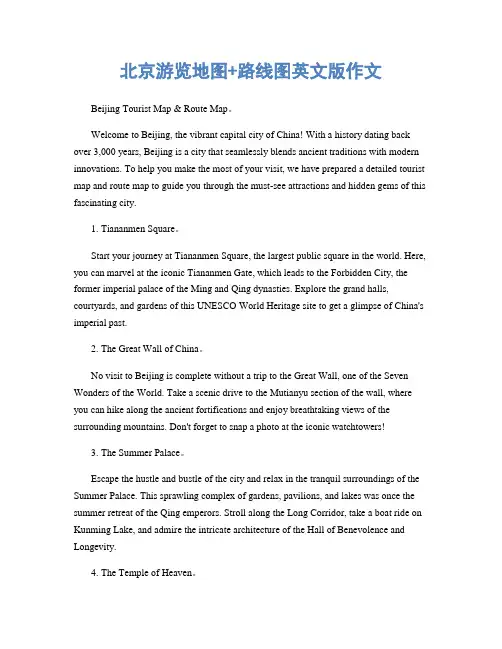
北京游览地图+路线图英文版作文Beijing Tourist Map & Route Map。
Welcome to Beijing, the vibrant capital city of China! With a history dating back over 3,000 years, Beijing is a city that seamlessly blends ancient traditions with modern innovations. To help you make the most of your visit, we have prepared a detailed tourist map and route map to guide you through the must-see attractions and hidden gems of this fascinating city.1. Tiananmen Square。
Start your journey at Tiananmen Square, the largest public square in the world. Here, you can marvel at the iconic Tiananmen Gate, which leads to the Forbidden City, the former imperial palace of the Ming and Qing dynasties. Explore the grand halls, courtyards, and gardens of this UNESCO World Heritage site to get a glimpse of China's imperial past.2. The Great Wall of China。
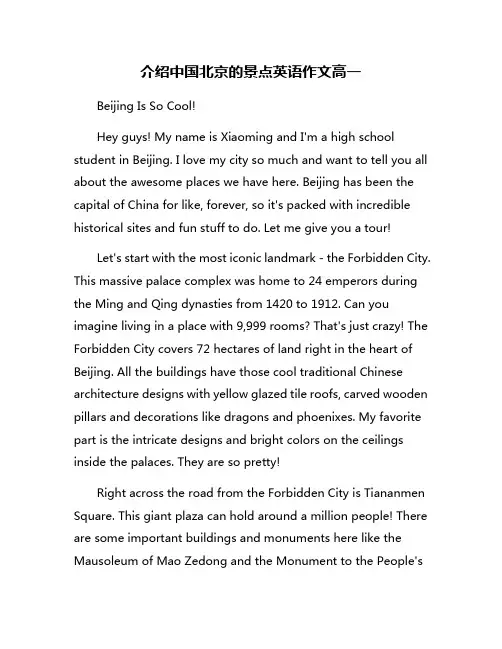
介绍中国北京的景点英语作文高一Beijing Is So Cool!Hey guys! My name is Xiaoming and I'm a high school student in Beijing. I love my city so much and want to tell you all about the awesome places we have here. Beijing has been the capital of China for like, forever, so it's packed with incredible historical sites and fun stuff to do. Let me give you a tour!Let's start with the most iconic landmark - the Forbidden City. This massive palace complex was home to 24 emperors during the Ming and Qing dynasties from 1420 to 1912. Can you imagine living in a place with 9,999 rooms? That's just crazy! The Forbidden City covers 72 hectares of land right in the heart of Beijing. All the buildings have those cool traditional Chinese architecture designs with yellow glazed tile roofs, carved wooden pillars and decorations like dragons and phoenixes. My favorite part is the intricate designs and bright colors on the ceilings inside the palaces. They are so pretty!Right across the road from the Forbidden City is Tiananmen Square. This giant plaza can hold around a million people! There are some important buildings and monuments here like the Mausoleum of Mao Zedong and the Monument to the People'sHeroes. But the real highlight is getting photos in front of the iconic portrait of Mao Zedong hanging on the Tiananmen Gate. My friends and I like to goof around and pose like we're guarding the gate. Haha!Another must-see is the Temple of Heaven park. This was built in 1420 as a sacred place for emperors to pray for good harvests. The iconic round temple with its triple-eaved blue-tiled roof is just breathtaking. But my favorite spot is the Echo Wall where you can hear even a tiny whisper from the other side if you stand in the right spot. My friends and I spent hours whispering jokes to each other - it's hilarious!For some nature and fresh air, you have to check out the Summer Palace. This huge imperial garden dates back to 1750 and centers around a massive lake called Kunming Lake. You can rent a boat and row around the lake, passing by willow trees, jade bridges, temples and even a marble boat! At one end is the Long Corridor, a 700m covered walkway lined with 8,000 painting scenes. I love wandering through it while listening to the sounds of birds and fountains.Speaking of nature, no trip to Beijing is complete without hiking a section of the Great Wall. This amazing feat of construction snakes over mountains for thousands of miles! Theclosest section to Beijing is at Badaling, about an hour's drive away. Even though it's been reconstructed and turned into a tourist zone, it's incredible to be able to walk on this500-year-old wall. Make sure to bring lots of water and energy bars - that hike is no joke!For kids, the Beijing Zoo is the place to be. We have one of the largest populations of pandas in the world! You can watch the giant pandas tumbling and munching bamboo while little red pandas scamper around. My favorite animals are the snowy owls and cheeky monkeys. The zoo also has an awesome aquarium and reptile house with deadly snakes and massive crocodiles.No visit to Beijing is truly complete without sampling all the delicious food! Beijing is famous for dishes like juicy Peking roast duck, fresh dumplings and noodles like zhajiangmian (a dry noodle dish with a thick fermented soybean paste sauce). Street food is also huge here - grab a jianbing (crispy crepe stuffed with scrambled eggs and other fillings) or some tanghulu (candied fruit kabobs) from a street vendor. And for dessert, you must try the bingtanghulu - that's a frozen sweet yogurt bar dipped in sugar syrup!There's just so much to experience in this amazing city. The blend of ancient traditions, modern life, delicious cuisine and fun attractions make Beijing one of the coolest capitals in the world. You guys have to come visit sometime! I'll show you all the hot spots and we can make some awesome memories together. See you in Beijing!。
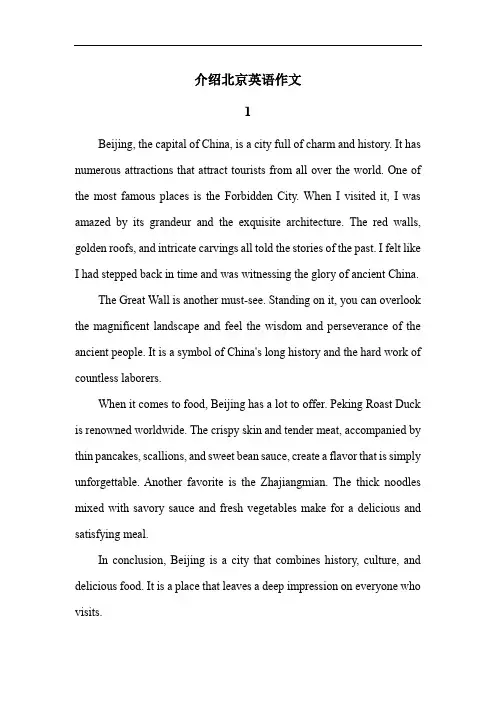
介绍北京英语作文1Beijing, the capital of China, is a city full of charm and history. It has numerous attractions that attract tourists from all over the world. One of the most famous places is the Forbidden City. When I visited it, I was amazed by its grandeur and the exquisite architecture. The red walls, golden roofs, and intricate carvings all told the stories of the past. I felt like I had stepped back in time and was witnessing the glory of ancient China.The Great Wall is another must-see. Standing on it, you can overlook the magnificent landscape and feel the wisdom and perseverance of the ancient people. It is a symbol of China's long history and the hard work of countless laborers.When it comes to food, Beijing has a lot to offer. Peking Roast Duck is renowned worldwide. The crispy skin and tender meat, accompanied by thin pancakes, scallions, and sweet bean sauce, create a flavor that is simply unforgettable. Another favorite is the Zhajiangmian. The thick noodles mixed with savory sauce and fresh vegetables make for a delicious and satisfying meal.In conclusion, Beijing is a city that combines history, culture, and delicious food. It is a place that leaves a deep impression on everyone who visits.Beijing, the capital of China, is a city that seamlessly blends ancient traditions with modern marvels. The traditional aspects, such as Peking Opera and Siheyuan, offer a glimpse into the rich cultural heritage. Peking Opera, with its elaborate costumes and captivating performances, has charmed audiences for centuries. The Siheyuan, on the other hand, provide a warm and inviting atmosphere. Stepping into a Siheyuan, you can feel the sense of community and family. The courtyard is often filled with the laughter of children and the chatter of neighbors.Modern buildings like the Bird's Nest and the Water Cube are symbols of Beijing's rapid development. The Bird's Nest, with its unique architecture, has hosted numerous international sports events. When attending a game there, the excitement is palpable. The roar of the crowd and the fierce competition on the field make for an unforgettable experience. The Water Cube, with its changing lights and innovative design, is a masterpiece of modern engineering.In Beijing, you can walk through ancient alleys one moment and stand in awe of modern skyscrapers the next. It is a city that constantly surprises and delights, where the past and the present coexist in harmony, creating a unique and enchanting charm that leaves a lasting impression on all who visit.Beijing, the capital of China, has undergone remarkable historical changes, evolving from an ancient city to a modern international metropolis.In the past, transportation in Beijing was quite different. People mainly relied on bicycles and buses. The roads were narrow and crowded. However, nowadays, the transportation system has been greatly improved. The subway network spreads all over the city, making it convenient for people to travel. High-speed railways connect Beijing with other major cities, reducing travel time significantly. And there are also numerous taxis and private cars on the roads.When it comes to urban planning, Beijing has also made innovative efforts. In the old days, the city was mainly composed of traditional courtyard houses and small alleys. But now, modern high-rise buildings, shopping malls, and parks have emerged. The expansion of the city has been carefully planned to ensure a balance between economic development and environmental protection. For example, many green spaces have been created to improve the living environment.The historical and cultural heritage of Beijing has also been well-preserved while the city is developing. Ancient palaces, temples, and walls still stand, telling the stories of the past.In conclusion, Beijing has successfully transformed itself whilemaintaining its unique charm. It continues to progress and attract people from all over the world.4Beijing, the capital of China, is a city brimming with profound cultural heritage. It is not only a political and economic center but also a cradle of literature and art. The city has witnessed the creation of numerous literary masterpieces. For instance, a renowned writer, Lao She, drew inspiration from the streets and alleys of Beijing, presenting the vivid lives of its people in his works.Education resources in Beijing are exceptionally rich. The prestigious universities, such as Peking University and Tsinghua University, attract talents from all over the country. I have had the privilege of studying in one of these institutions and experienced the stimulating academic atmosphere. The libraries are filled with knowledge, and the classrooms buzz with intellectual discussions.The art scene in Beijing is equally vibrant. From traditional Chinese painting to modern installations, various forms of art can be found. The museums house precious cultural relics, telling the story of China's long history. Theaters present wonderful performances, captivating the audience with their charm.In conclusion, Beijing is a city that combines history and modernity, tradition and innovation. Its cultural heritage continues to inspire and shapethe minds of people, making it a truly remarkable place.5Beijing, the capital of China, is not only a historical and cultural hub but also a modern metropolis that has made significant contributions to the world. In the realm of international communication, Beijing serves as a bridge connecting different cultures and nations. It hosts numerous international conferences and exhibitions, facilitating exchanges and cooperation among countries.For instance, the 2008 Olympics was a grand event held in Beijing, which attracted athletes and spectators from all over the world. This event showcased Beijing's excellent organizational capabilities and demonstrated China's openness and friendliness to the global community.In the field of technological innovation, Beijing has achieved remarkable breakthroughs. It is home to many leading tech companies and research institutions that are constantly pushing the boundaries of science and technology. The development of 5G technology, artificial intelligence, and new energy vehicles in Beijing has had a profound impact on the global technological landscape.Furthermore, Beijing's cultural influence is also spreading worldwide. Its traditional art forms, such as Peking Opera and calligraphy, are appreciated and studied by people from different countries. At the same time, modern cultural expressions like contemporary art and music are alsoflourishing in this city.In conclusion, Beijing's development in various fields has not only enhanced its own status but also had a positive and far-reaching influence on the world, making it an indispensable part of the global community.。
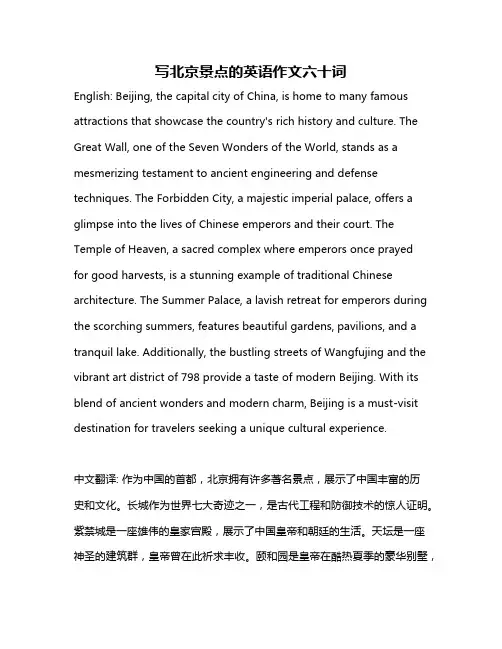
写北京景点的英语作文六十词English: Beijing, the capital city of China, is home to many famous attractions that showcase the country's rich history and culture. The Great Wall, one of the Seven Wonders of the World, stands as a mesmerizing testament to ancient engineering and defense techniques. The Forbidden City, a majestic imperial palace, offers a glimpse into the lives of Chinese emperors and their court. The Temple of Heaven, a sacred complex where emperors once prayedfor good harvests, is a stunning example of traditional Chinese architecture. The Summer Palace, a lavish retreat for emperors during the scorching summers, features beautiful gardens, pavilions, and a tranquil lake. Additionally, the bustling streets of Wangfujing and the vibrant art district of 798 provide a taste of modern Beijing. With its blend of ancient wonders and modern charm, Beijing is a must-visit destination for travelers seeking a unique cultural experience.中文翻译: 作为中国的首都,北京拥有许多著名景点,展示了中国丰富的历史和文化。
中国各大城市景点英文版以下是中国各大城市的著名景点英文版介绍:1. 北京:故宫:Forbidden City天安门广场:Tiananmen Square长城:Great Wall颐和园:Summer Palace2. 上海:外滩:The Bund东方明珠塔: Oriental Pearl Tower南京路步行街:Nanjing Road Walkway豫园:Yu Garden3. 广州:广州塔: Canton Tower白云山风景名胜区: Baiyun Mountain Scenic Area珠江夜游: Zhujiang River Night Cruise陈家祠: Chen Clan Ancestral Hall4. 深圳:世界之窗: Window of the World大梅沙海滨公园: Dameisha Beach Park深圳湾公园: Shenzhen Bay Park深圳欢乐谷: Shenzhen Happy Valley东部华侨城: East OCT5. 成都:大熊猫繁育研究基地: Chengdu Research Base of Giant Panda Breeding 都江堰: Dujiangyan Irrigation System青城山: Qingcheng Mountain武侯祠: Wuhou Shrine6. 杭州:西湖: West Lake灵隐寺: Lingyin Temple千岛湖: Thousand Island Lake宋城: Song City7. 西安:大雁塔: Big Wild Goose Pagoda华清池: Huaqing Hot Spring西安城墙: Xi'an City Walls古城墙: City Walls of Xi'an秦始皇兵马俑博物馆: Terracotta Warriors Museum 陕西历史博物馆: Shaanxi History Museum8. 南京:中山陵: Dr. Sun Yat-sen's Mausoleum夫子庙: Confucius Temple总统府: Presidential Palace明孝陵: Ming Xiaoling9. 苏州:拙政园: Zhuozheng Garden留园: Liuyuan Garden虎丘: Tiger Hill苏州园林: Classical Gardens of Suzhou10. 重庆:解放碑: Liberation Monument洪崖洞: Hongyadong南山一棵树观景台: Nanshan One Tree Viewpoint 磁器口古镇: Ciqikou Ancient Town11. 武汉:黄鹤楼: Yellow Crane Tower东湖: East Lake汉口江滩: Han口的江滩Kou Jiangtan武汉长江大桥: Wuhan Yangtze River Bridge 12. 厦门:鼓浪屿: Gulangyu Island南普陀寺: Nanputuo Temple环岛路: Island Ring Road曾厝垵: Zengcuo'an13. 青岛:栈桥: Zhanqiao Pier八大关: Badaguan Scenic Area崂山: Laoshan Mountain青岛啤酒博物馆: Tsingtao Beer Museum石老人海滩: Shilaoren Beach德国风情街: German Style Street14. 大连:星海广场: Xinghai Square金石滩: Golden Pebble Beach老虎滩海洋公园: Laohutan Ocean Park森林动物园: Dalian Forest Zoo棒棰岛: Bangchui Island15. 长沙:岳麓山: Yuelu Mountain橘子洲: Juzizhou Island天心阁: Tianxin Pavilion湖南省博物馆: Hunan Provincial Museum 16. 昆明:石林: Shilin Scenic Area滇池: Dianchi Lake西山: Western Hills世博园: Expo Garden17. 丽江:古城: Old Town of Lijiang玉龙雪山: Jade Dragon Snow Mountain束河古镇: Shuhe Ancient Town泸沽湖: Lugu Lake18. 杭州:西湖十景: Ten Scenic Spots of West Lake灵隐飞来峰: Feilaifeng, Lingyin Temple钱塘江大桥: Qiantang River Bridge杭州宋城: Song City, Hangzhou西溪湿地公园: Xixi Wetland Park灵隐寺: Lingyin Temple杭州乐园: Hangzhou Amusement Park19. 成都:锦里古街: Jinli Ancient Street宽窄巷子: The Wide and Narrow Alleys都江堰水利工程: Dujiangyan Irrigation Project大熊猫繁育研究基地: Chengdu Panda Breeding and Research Center 20. 天津:五大道: The Five大道Big Roads瓷房子: Porcelain House天津之眼: Tianjin Eye Ferris Wheel古文化街: Ancients Culture Street21. 桂林:漓江: Lijiang River象山: Elephant Trunk Hill龙脊梯田: Longji Terraced Fields阳朔西街: Yangshuo West Street22. 黄山:奇松: Unique Pine Trees怪石: Strange Rock Formations云海: Sea of Clouds温泉: Hot Springs23.太原:晋祠: Jin Shrine双塔寺: Twin Pagodas Temple纯阳宫: Chunyang Palace崇善寺: Chongshan Temple24. 兰州:黄河铁桥: Yellow River Iron Bridge白塔山: Bai塔山Ta Mountain五泉山公园: Wǔquánshān Park兰州牛肉面博物馆: Lanzhou Beef Noodle Museum 25. 合肥:包公祠: Bao Gong Shrine三河古镇: Sanhe Ancient Town徽州古城: Huizhou Ancient City巢湖: Chaohu Lake26. 南昌:滕王阁: Tengwang Pavilion八一起义纪念馆: August 1 Uprising Memorial Hall 秋水广场: Qiushui Square南昌之星摩天轮: Nanchang Star Ferris Wheel27. 南宁:青秀山: Qingxiu Mountain南湖公园: Nanhua Park广西民族大学: Guangxi Minzu University中山路夜市: Zhongshan Road Night Market 28. 石家庄:正定古城: Zhengding Ancient City赵州桥: Zhaozhou Bridge抱犊寨风景区: Baodu Zhai Scenic Area龙泉公园: Longquan Park29. 济南:大明湖: Daming Lake趵突泉公园: Baotu Spring Park千佛山: Thousand Buddha Mountain山东博物馆: Shandong Museum30. 沈阳:沈阳故宫: Shenyang Imperial Palace北陵公园: Beiling Park张氏帅府: Zhang Shuai Mansion中街步行街: Zhongjie Walkway31. 哈尔滨:中央大街: Central Street圣索菲亚教堂: Saint Sophia Cathedral松花江大桥: Songhua River Bridge太阳岛风景区: Sun Island Scenic Area 32. 郑州:登封嵩山: Dengfeng Songshan黄河游览区: Yellow River Tourism Area 郑州博物馆: Zhengzhou Museum二七纪念塔: Erqi Memorial Tower33. 洛阳:龙门石窟: Longmen Grottoes白马寺: White Horse Temple洛阳古城: Luoyang Ancient City天子驾六博物馆: Heavenly King's Chariots Museum34. 乌鲁木齐:天山天池: Tianshan Tianchi Lake红山公园: Hongshan Park新疆博物馆: Xinjiang Museum国际大巴扎: Urumqi International Bazaar35. 呼和浩特:大召寺: Dazhao Temple五塔寺: Wutata Temple草原文化博物馆: Grassland Cultural Museum阿尔泰游乐园: Aerta Amusement Park36. 福州:三坊七巷: Three Lanes and Seven Alleys福州西湖公园: Fuzhou West Lake Park福建农林大学: Fujian Agriculture and Forestry University 鼓山寺: Gushan Temple37. 厦门:环岛路: Island Ring Road曾厝垵: Zengcuo'an南靖土楼: Nanjing Tulou厦门大学: Xiamen University38. 珠海:珠海渔女: Zhuhai Mermaid Statue情侣路: Lovers' Road圆明新园: Yuanming New Garden澳门旅游塔: Macao Tower39. 汕头:华侨博物馆: Overseas Chinese Museum澄海陈慈黉故居: Chenghai Chen Cihong's Former Residence 南澳岛: Nanao Island汕头大学: Shantou University。
北京旅游景点英文版Beijing, the capital of China, is filled with iconic tourist attractions. Here are some popular tourist spots in Beijing:1. The Great Wall of China (长城): This ancient wonder stretches for over 13,000 miles and is a must-visit attraction for all tourists.2. The Forbidden City (紫禁城): Located in the heart of Beijing, this palace complex served as the imperial palace during the Ming and Qing dynasties. It is now a UNESCO World Heritage site.3. Tiananmen Square (天安门广场): Known as the largest public square in the world, Tiananmen Square holds great historical and cultural significance. It is also home to the Chairman Mao Memorial Hall.4. The Summer Palace (颐和园): A stunning imperial garden, the Summer Palace offers beautiful landscapes, ancient pavilions, and a serene lake. Visitors can also enjoy a boat ride on Kunming Lake.5. The Temple of Heaven (天坛): This sacred temple was used by emperors of the Ming and Qing dynasties to pray for a good harvest. It is a masterpiece of ancient Chinese architecture.6. The Ming Tombs (明十三陵): Located in the suburbs of Beijing, the Ming Tombs is the resting place of 13 out of the 16 Ming dynasty emperors.7. The Lama Temple (雍和宫): This Tibetan Buddhist temple isone of the largest and most important in Beijing. The highlight is a 26-meter-high statue of Maitreya Buddha carved from a single piece of sandalwood.8. The National Museum of China (中国国家博物馆): This museum showcases an extensive collection of Chinese historical artifacts, including ancient bronze ware, jade, ceramics, and calligraphy.9. The 798 Art District (798艺术区): This former factory district has been transformed into an art district, with galleries, studios, and shops. It is a hub for contemporary art and culture.10. Hutongs (胡同): Explore the traditional narrow alleyways of Beijing by visiting the Hutongs. These historic neighborhoods offer a glimpse into the city's ancient past.These are just a few of the many attractions Beijing has to offer. There is so much more to explore in this vibrant and historical city.。
描写北京景点英文作文英文:Beijing, the capital of China, is a city rich inhistory and culture. There are many famous tourist attractions in Beijing, such as the Great Wall, the Forbidden City, and the Temple of Heaven.The Great Wall is a must-visit attraction when visiting Beijing. It is one of the Seven Wonders of the World and is a symbol of China's ancient civilization. I remember when I visited the Great Wall last summer, I was amazed by the grandeur and magnificence of the wall. I also learned about the history of the wall and how it was built to protect China from invaders.The Forbidden City is another popular attraction in Beijing. It was the imperial palace during the Ming and Qing dynasties and is now a museum. When I visited the Forbidden City, I was impressed by the intricatearchitecture and the beautiful gardens. I also learned about the lives of the emperors and the history of the palace.The Temple of Heaven is a religious site in Beijing and is known for its beautiful architecture and peaceful atmosphere. When I visited the Temple of Heaven, I was struck by the beauty of the buildings and the serene surroundings. I also learned about the rituals and ceremonies that were performed at the temple.Overall, Beijing is a city full of history and culture, and there are many other attractions to explore, such as the Summer Palace, the National Museum of China, and the Beijing Zoo.中文:北京是中国的首都,是一个拥有丰富历史和文化的城市。
介绍北京旅游景点的英语作文五年级60字English: Beijing, the capital of China, is a city rich in history and culture, with a wide range of tourist attractions. One of the most famous landmarks is the Great Wall, a must-see for visitors lookingto learn about China's ancient history. The Forbidden City, located in the center of Beijing, is another popular destination, known for its impressive imperial architecture and stunning artwork. For a taste of traditional Chinese culture, tourists can visit the Temple of Heaven, where emperors used to pray for good harvests. And for a touch of modernity, the Bird's Nest and Water Cube, iconic structures fromthe 2008 Olympics, are great options. Overall, Beijing offers a perfect blend of ancient charm and modern allure for tourists to enjoy.Translated content: 北京是中国的首都,拥有丰富的历史和文化,拥有着各种各样的旅游景点。
北京旅游景点英文版北京旅游景点介绍1、北京天安门广场与人民英雄纪念碑 Beijing Tiananmen square and themonument to the people's heroes景点简介:Scenic Spots IntroductionIt is the capital of the symbol of Beijing。
It is located in the capital of the people's Republic of Beijing city center,east ofChang'an Avenue, south of the Imperial Palace。
It is surrounded by the front door, the Chairman Mao Memorial Hall, the monument to the people's heroes, Tiananmen,the Imperial Palace, the Museum of the Chinese revolution, the Great Hall of the people, theworking people's Cultural Palace, Zhongshan Park, the National Grand Theater and so on.首都北京的象征。
它坐落在中华人民共和国首都北京的市中心的东长安街上,故宫南侧。
周围有前门、毛主席纪念堂、人民英雄纪念碑、天安门城楼、故宫、中国革命历史博物馆、人民大会堂、劳动人民文化宫、中山公园、国家大剧院等景点。
交通概况:Traffic surveyNo.1, 4, 20, 52, 101, 103, 57, 109 , Metro Line 1, Metro Line 2. 乘1、4、20、52、57路101、103、109路公共汽车、地铁1号线天安门东、天安门西,2号线前门站均可到达。
北京景点英语作文English:Beijing, the capital city of China, is home to numerous famous attractions that showcase the country's rich history and culture. One of the most iconic landmarks is the Great Wall, a UNESCO World Heritage Site that spans over 13,000 miles and attracts millions of visitors each year. The Forbidden City is another must-visit destination in Beijing, with its grand imperial architecture and intricate designs. The Temple of Heaven, a symbol of ancient Chinese religious practices, offers a tranquil escape from the bustling city. For those interested in traditional Chinese arts, the Summer Palace is a perfect blend of stunning architecture, lush gardens, and serene lakes. The vibrant streets of Wangfujing and the modern architecture of the Bird's Nest stadium also provide a glimpse into the dynamic and evolving city of Beijing. With so much to see and do, Beijing is truly a treasure trove of cultural wonders waiting to be explored.中文翻译:北京作为中国的首都,拥有许多著名景点,展示了这个国家丰富的历史和文化。
长城 the Great Wall
北海公园 Beihai Park 颐和园 Summer Palace 圆明园 Yuanming Yuan 天坛 Temple of Heaven 紫禁城 the Forbidden City 天池 Heaven Pool
御花园 Imperial Garden 北京植物园Beijing Botanical Garden
乾清宫 Palace of Heavenly Purity Olympic Green 奥林匹克公园
National Aquatic Center 水立方(Bird's Nest/Olympic Stadium)鸟巢
人民大会堂 the Great Hall of the People 北京工人体育馆 Beijing Worker's Stadium 少年宫 the Children's Palace 烽火台the Beacon Tower
天安门广场 Tian'anmen Square 故宫博物院 the Palace Museum
长城 the Great Wall
北海公园 Beihai Park 颐和园 Summer Palace 圆明园 Yuanming Yuan 天坛 Temple of Heaven 紫禁城 the Forbidden City 天池 Heaven Pool
御花园 Imperial Garden 北京植物园Beijing Botanical Garden
乾清宫 Palace of Heavenly Purity Olympic Green 奥林匹克公园
National Aquatic Center 水立方(Bird's Nest/Olympic Stadium)鸟巢
人民大会堂 the Great Hall of the People 北京工人体育馆 Beijing Worker's Stadium 少年宫 the Children's Palace 烽火台the Beacon Tower
长城 the Great Wall
北海公园 Beihai Park 颐和园 Summer Palace 圆明园 Yuanming Yuan 天坛 Temple of Heaven 紫禁城 the Forbidden City 天池 Heaven Pool
御花园 Imperial Garden
北京植物园Beijing Botanical Garden
乾清宫 Palace of Heavenly Purity
Olympic Green 奥林匹克公园
National Aquatic Center 水立方
(Bird's Nest/Olympic Stadium)鸟巢
人民大会堂 the Great Hall of the People
北京工人体育馆 Beijing Worker's Stadium
少年宫 the Children's Palace
烽火台the Beacon Tower。